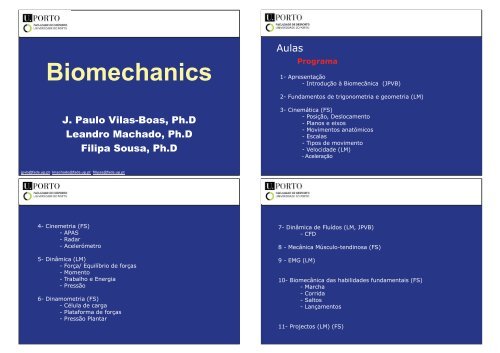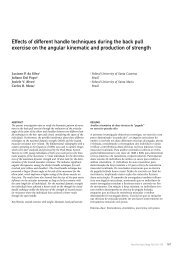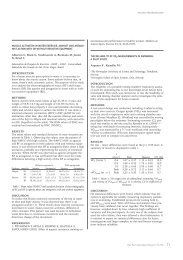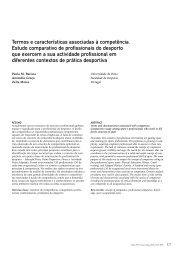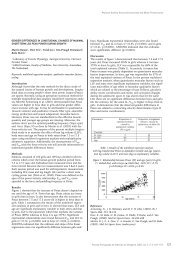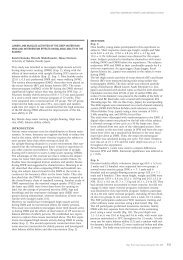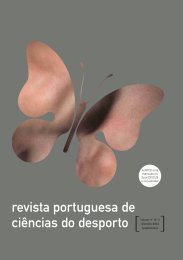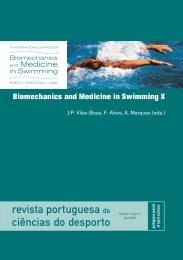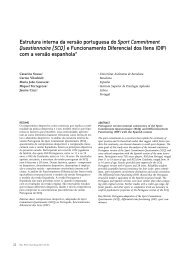Biomechanics
Biomechanics
Biomechanics
You also want an ePaper? Increase the reach of your titles
YUMPU automatically turns print PDFs into web optimized ePapers that Google loves.
<strong>Biomechanics</strong><br />
J. Paulo Vilas-Boas, Ph.D<br />
Leandro Machado, Ph.D<br />
jpvb@fade.up.pt; lmachado@fade.up.pt; filipas@fade.up.pt<br />
4- Cinemetria (FS)<br />
- APAS<br />
- Radar<br />
- Acelerómetro<br />
Filipa Sousa, Ph.D<br />
5- Dinâmica (LM)<br />
- Força/ Equilíbrio de forças<br />
- Momento<br />
- Trabalho e Energia<br />
- Pressão<br />
6- Dinamometria (FS)<br />
- Célula de carga<br />
- Plataforma de forças<br />
- Pressão Plantar<br />
Aulas<br />
Programa<br />
1- Apresentação<br />
- Introdução à Biomecânica (JPVB)<br />
2- Fundamentos de trigonometria e geometria (LM)<br />
3- Cinemática (FS)<br />
- Posição, Deslocamento<br />
- Planos e eixos<br />
- Movimentos anatómicos<br />
- Escalas<br />
- Tipos de movimento<br />
- Velocidade (LM)<br />
- Aceleração<br />
7- Dinâmica de Fluídos (LM, JPVB)<br />
- CFD<br />
8 - Mecânica Músculo-tendinosa (FS)<br />
9 - EMG (LM)<br />
10- Biomecânica das habilidades fundamentais (FS)<br />
- Marcha<br />
- Corrida<br />
- Saltos<br />
- Lançamentos<br />
11- Projectos (LM) (FS)
Bibliografia<br />
<strong>Biomechanics</strong><br />
Introductory concepts<br />
Introductory concepts
Força / Peso<br />
Força / Peso<br />
15<br />
10<br />
5<br />
Nelson Évora - componente vertical 4 passagens<br />
0<br />
0 20 40 60 80 100<br />
t<br />
norm<br />
12<br />
10<br />
8<br />
6<br />
4<br />
2<br />
Naide Gomes - componente vertical 3 passagens<br />
0<br />
0 20 40 60 80 100<br />
t<br />
norm
BIO MECHANICS<br />
Physics<br />
Thermodynamics (energetics)<br />
Electricity<br />
Optics<br />
Biophysics<br />
Biology<br />
Bioenergetics<br />
Bioelectricity<br />
Bio-optics<br />
Mechanics <strong>Biomechanics</strong><br />
<br />
<br />
MECHANICS<br />
Physics:<br />
“The quest for the TOTAL theory”<br />
The movement (and balance) study<br />
How is the movement (or balance) like?<br />
What causes the movement (or balance)?
BIO<br />
Complexity:<br />
Organization:<br />
Heterogeneity<br />
Articulated<br />
Redundant<br />
Behavior:<br />
Self propelled<br />
Arbitrary<br />
Biodiversity<br />
BIO MECHANICS<br />
SUBJECT:<br />
Non<br />
deterministic<br />
The forces produced and<br />
acting over the biological<br />
systems, and the<br />
movements and balances<br />
that they produce<br />
BIO MECHANICS<br />
The study of the<br />
biological systems,<br />
based on criterions,<br />
principles, laws, and<br />
methods of mechanics<br />
Historical highlights<br />
From Nigg & Herzog (1994)
Historical highlights Historical highlights<br />
Historical highlights<br />
Antiquity – Greeks – Natural Philosophy<br />
Thales (624-545 B.C.)<br />
Pythagoras<br />
(582 B.C.) &<br />
Hippocrates<br />
(470-360 B.C.)<br />
From Nigg & Herzog (1994)<br />
Natural science detached from religion<br />
“…all things have form, all things are form, and all forms can be defined by<br />
numbers”<br />
Pythagoras believed that mathematical relations held the secrets of the<br />
universe, including music.<br />
Hippocrates’ emphasis on observation and experience of the senses<br />
pioneered the use of rational scientific thought in the practice of<br />
medicine.<br />
Antiquity<br />
Maya<br />
Egyptians<br />
Mesopotamians<br />
Phoenicians<br />
Greeks<br />
Developed knowledge:<br />
Astronomy, Mathematics, …<br />
Leisure & Sport<br />
Natural Philosophy<br />
Golden age<br />
Hellenistic age<br />
Conquest by the Roman Empire<br />
Historical highlights<br />
Antiquity – Greeks – Golden age<br />
Plato (427-347 B.C.) believed the world of senses to be an illusory shadow of<br />
reality. Ideas were the only reality, and true knowledge could not be obtained<br />
through the study of nature. The pursuit of truth required contemplation, not<br />
action.<br />
Politics and Ethics prevail.<br />
Knowledge & Myth<br />
Kinematics<br />
and Art;<br />
Surface<br />
Anatomy<br />
(Plato and Aristotle)<br />
Aristotle (384-322 B.C.) believed that mathematics provided a good model for a well-organized<br />
science, and that science is aimed to explain nature.<br />
Aristotle believed life was capable of mechanical expression. According to him, every motion<br />
presupposed a mover.<br />
All that is moved, should be moved by something else. The MOTOR must either be present within<br />
the mobile, or be in direct contact with it. Action at a distance was inconceivable.<br />
Aristotle's’ text About the Movement of Animals, described movement and locomotion (gait,<br />
muscular action,…) for the first time, based on observation.<br />
“… for just as the pusher pushes, so the pusher is pushed”
Historical highlights<br />
Antiquity – Greeks – The Hellenistic age<br />
Founded by the conquests of Alexander the Grate<br />
and the foundation of Alexandria (The Museum of Alexandria)<br />
Herophilos (300 B.C.) – Created the modern Anatomy and Physiology, with the systematic dissection.<br />
Erasistratis (280 B.C) – Applied physical concepts to the understanding of anatomy. Was the first to<br />
describe the muscles as organs of contraction.<br />
Archimedes (287-212 B.C.) – With a lever he will move the Earth if he have a place<br />
to stand to do so.<br />
Equilibrium of Planes – How to find the CG of parallelogram, triangle, trapezium<br />
Floating Bodies – Principles of water displacement<br />
“How to move a given weight by given force?”<br />
He dominated Statics and Hydrostatics until the time of Stevin (1548-1620) and<br />
Galileo Galilei (1564-1642)<br />
Historical highlights<br />
Antiquity<br />
- Knowledge and myth were separated<br />
- Mechanical and mathematical paradigms were developed<br />
- Anatomical paradigms were developed<br />
- First biomechanical analysis of the human body was performed<br />
Historical highlights<br />
Antiquity – Greeks – The conquest by Rome<br />
Hero of Alexandria 62 ( A.D.) – Teaches Physics at Alexandria (Mechanics, Optics, Pneumatics) He used<br />
gases to invent mechanisms.<br />
The Aristotelic causes of movement<br />
Galen 131-201 ( A.D.) – Physician of the College of Gladiators, became probably the first Sport<br />
Physician in History.<br />
De Usu Partium (the Use of the Parts) is considered to be the first text on Physiology<br />
De Motu Musculorum (On the movement of muscles) established Myology. “…enervation that makes<br />
muscle substance into muscle proper” (the transmitters of the spiritus animalius from the brain into<br />
the muscle.<br />
He described tonus, and distinguished between agonistic and antagonistic muscles, and motor and<br />
sensory nerves.<br />
Historical highlights<br />
The Middle Ages (200 B.C.-1450 A.D.)<br />
Scientific Development decreased<br />
Religious and spiritual<br />
development increased<br />
Those were the ages of the ARAB scholars, saving knowledge by translating the texts from<br />
Greek to Arabic<br />
St. Augustine (354-430 A.D.) incorporated Neoplatonic doctrines into<br />
Christian beliefs.<br />
“… the only type of knowledge to be desired was the knowledge of God<br />
and the Soul, and no profit was to be had from investigating the realm of<br />
nature”<br />
St. Thomas Aquinas (1277) integrated Aristotelian philosophy into<br />
Christian beliefs, from the Arabic translations.<br />
Contributions of the MA to the development of <strong>Biomechanics</strong> are minimal.
Historical highlights<br />
The Italian Renaissance (1450-1527)<br />
The revival of ancient Greek Philosophy, Literature, Art and freedom of thought and<br />
ethics. Nevertheless a scientific community didn’t exist.<br />
The authority of the church was replaced by the authority of the<br />
ancients<br />
Michelangelo, Leonardo da Vinci (1452-1519) and Machiavelli<br />
emerged as the Renaissance men.<br />
The parallelogram of forces, simple and compound forces, studied friction, and questioned<br />
Aristotle’s relationships between force, weight, and velocity.<br />
“… an object offers as much resistance to the air as the air does to the object”<br />
Da Vinci’s mechanical analysis of human movement included joints, muscles, bones, ligaments,<br />
tendons and cartilage. He discarded the Aristotelian theory of Pneuma. “Spiritual force” replaced<br />
it.<br />
Historical highlights<br />
The Italian Renaissance (1450-1527)<br />
- Scientific work was revived<br />
- The foundations of modern anatomy and physiology were laid<br />
- Movement and muscle action were studied as connected<br />
entities.<br />
Historical highlights<br />
The Italian Renaissance (1450-1527)<br />
Vasselius (1514-1564) – Was authorised to make dissections of<br />
cadavers of executed criminals and noticed that Galen’s anatomy<br />
mixed human and animal characteristics.<br />
De Humani Corporis Fabrica Libri Septem was published in 1543,<br />
in the same year as Copernico’s Revolutionibus Orbium<br />
Coelestium.<br />
Vesalius demonstrated that muscle shortens and become thicker<br />
during contraction.<br />
He consider muscle to be compose of the substance of the<br />
ligament and tendon, being divided into a great number of fibres<br />
Fallopius (1523-1562) – Was mainly devoted to fibrous tissues:<br />
“… motion requires a fibrous nature sin the actual body that is<br />
moved.”. He adopted the Galen’s theory that the Spiritus<br />
Animalis was the cause of muscular contraction, and carrier of<br />
the motor/spiritual function of the brain.<br />
Historical highlights<br />
The Scientific Revolution of the XVII th century<br />
Kings, Counts, wealthy families, Universities, and the Vatican supported men of science -<br />
Galileu Galilei (1564-1642), Kepler (1571-1630), Descartes (1596-1650), Newton (1642-1727)<br />
Intellectual freedom, as well as new ideas and finings were highly respected<br />
Experimentation becomes the cornerstone<br />
Galileu Galilei (1564-1642) – Showed that the rate of a fall is not a function of the falling object’s<br />
weight (Aristotelian approach).<br />
He was about to publish De Animaliam Motibus (The movement of animals), previously than<br />
Borelli’s De Motu Animalum (1680-81) by 40 years!<br />
He studied the biomechanics of human jump, the gait oh horses and insects, and human<br />
floatability conditions (Discourses on Two New Sciences, 1638).<br />
Scaling foundations were introduced (the three times sized animal femur).
Historical highlights<br />
The Scientific Revolution of the XVIIth century<br />
Galileu Galilei (1564-1642) The father of <strong>Biomechanics</strong><br />
Theory of uniform movement<br />
Theory of projectiles<br />
Theory of the inclined plane<br />
The definition of Momentum<br />
Foundations for the three laws of Newton<br />
“If I was able to see further was because I stood<br />
on the shoulders of giants”<br />
Santorio (1561-1636) – Weighted himself and his solid and liquid inputs and<br />
output, experiments were laying the foundations of metabolism.<br />
William Harvey (1578-1657) – Discovered circulation, the capillaries<br />
connecting the arterial and venous circulation (without a microscope!), and<br />
the systole as the active action of the heart (against Gelen’s concept).<br />
Described the heart as a pump. He was the first “Cardiac Biomechanicist”.<br />
He died of a stroke.<br />
Renée Descartes (1596-1650) – Discovered the Cartesian Coordinate System observing a fly in<br />
the corner of the bedroom. One of the fathers of Mechanical Philosophy: “Changes observed in<br />
the natural world should be explained only in terms of motion and rearrangements of parts of<br />
matter” (L’homme, 1664, distinguish man from animals by the soul).<br />
Historical highlights<br />
The Scientific Revolution of the XVIIth century<br />
Isaac Newton (1642-1727), the “orchestra conductor”<br />
(Koestler, 1959)<br />
Kepler´s lows of motion of heavenly bodies<br />
Galileo’s law of falling bodies and projectiles<br />
Descartes law of inertia which require straight motion if no external force acted<br />
Philosophiae Naturalis Principia Methematica (1686)<br />
The law of inertia<br />
The law of acceleration due to an acting force<br />
The law of action and reaction<br />
The law of gravity<br />
The fundamental tool for kinematic and<br />
kinetic analysis of movement<br />
All motions in the universe can be described and / or predicted. As long as the movement was<br />
with relative speeds, which were small compared to the speed of light.<br />
Historical highlights<br />
The Scientific Revolution of the XVIIth century<br />
Giovanni Borelli (1608-1679), was granted by Queen Christina for the<br />
investigation of the mechanics of the human body<br />
The father of <strong>Biomechanics</strong>?<br />
The Motu Animalum, 1680<br />
Historical highlights<br />
The Scientific Revolution of the XVIIth century<br />
Jan Swammerdam (1643-1680) – Constancy of frog’s muscle volume during contraction<br />
William Croone (1633-1684) – The brain must send a signal to the muscles to cause contraction<br />
Niels Stensen (1638-1686) – Precise descriptions of muscular structure<br />
Francis Glisson (1597-1677) – The theory of irritability of muscles<br />
Clopton Havers (1655-1702) – Systematic study of bone with a microscope. Bone is organic and<br />
inorganic in nature, with tubular cavities.
Historical highlights<br />
The Scientific Revolution of the XVIIth century<br />
- Experiment and theory were introduced as complementary parts<br />
of scientific investigation<br />
- The Newtonian mechanics was established<br />
- The Mechanical Philosophy and Newtonian mechanics provide<br />
impetus to study human movement<br />
Historical highlights<br />
The Enlightenment: XVIIIth Century<br />
Science was not organized as today: the current subdivision into disciplines started at that time!<br />
Von Haller (1708-1777) – Recognised the role of electricity (a new discover) in muscle contraction,<br />
but refrain to associate it to the “spiritus animalius” that controlled movements<br />
Keill (1674-1719) – Calculated the number of fibres in a certain muscle and the tension per fibre to<br />
lift a given weight<br />
Daniel Bernoulli (11700-1728) – Developed a mechanical theory of muscle contraction. Breathing<br />
and the mechanical work of the heart were also studied.<br />
Nicholas Andre (1658-1742) – Coined the term “orthopaedics” (1741) and postulated that muscle<br />
unbalances can produce skeleton deformities. Exercise in childhood is recommended to prevent<br />
deformities<br />
Jean Jallabert (1746) – Was the first to rehabilitate paralysed muscles through electricity<br />
Luigi Galvani (1737-1798) – Muscles and nervous cells are able to produce electricity<br />
- Galvanic Electricity. He is considered the father of Bioelectricity.<br />
Robert Whytt (1714-1766) – Demonstrate the reflex action in the spinal chord in 1751,<br />
and localized the sites of single reflexes<br />
Historical highlights<br />
The Enlightenment: XVIII th Century<br />
Science was not organized as today: the current subdivision into disciplines started at that time!<br />
Euler (1707-1783), D’Alembert, Lagrange<br />
Euler (1707-1783) – Expanded Newton’s laws to be applied to rigid and<br />
fluid bodies on Earth, and not only to material points and celestial<br />
bodies. He start to develop the concept of conservation of energy<br />
D’Alembert (1717-1783) – Expanded Newton’s action / reaction law to<br />
moving objects<br />
Lagrange (1736-1815) – Treated mechanical problems with differential<br />
calculus. Newton’s 2nd law was expressed in terms of kinetic and<br />
potential energy.<br />
Historical highlights<br />
The Enlightenment: XVIIIth Century<br />
- The concept of force become more clearly understood<br />
- The concepts of conservation of momentum and energy started<br />
to develop<br />
- Mathematical consolidation of mechanical laws took place<br />
- Muscle contraction and action was recognised as influenced by<br />
mechanical, bio-chemical, and electrical forces
Historical highlights<br />
The XIX th Century: the gait century<br />
Development of science and its applications to human movement during the XIX th century was<br />
influenced by the XVIII th Century, namely: Rousseau, the Watt’s Steam Machine, and the French<br />
Revolution<br />
Development of<br />
sport and leisure<br />
J. J. Rousseau (1712-1778) – Emile (1762) – Revived the<br />
complementarities between body and mind, encouraging the return to<br />
NATURE and PHYSICAL ACTIVITY<br />
J. Watt (1736-1819) – Invented the Steam Machine (1777) – Potentiated<br />
the industrial revolution, the LEISURE time, recreation, and SPORTS<br />
French Revolution (1789) – The end of the monopoly of leisure and<br />
sports by the dominant social classes.<br />
Renewed scientific interest in human locomotion<br />
Historical highlights<br />
The XIX th Century: the gait century<br />
Marey (1838-1904)<br />
Historical highlights<br />
The XIX th Century: the gait century<br />
Renewed scientific interest in human locomotion<br />
Observation<br />
Photography Quantification of human and animal locomotion<br />
Eduard Weber (1795-1881) and Wilhelm Weber (1804-1891) – Published in<br />
1836 the “Die Mechanik der menchlichen Gewerkzeuge” (On the mechanics of<br />
the human gait tools)<br />
Etienne Jules Marey (1838-1904) – Transformed the science<br />
of locomotion from observational to one based on<br />
quantification<br />
Edward Muybridge (1830-1904) – Was introduced to animal<br />
movement analysis by Mr. Stanford (Stanford University),<br />
to explain high speed trot in horses. He produced about<br />
20.000 images of human and animal locomotion.<br />
Historical highlights<br />
The XIX th Century: the gait century<br />
Marey (1838-1904)<br />
Etienne Jules Marey (1838-1904) – Was the first to combine and synchronize kinematic and<br />
kinetic measurements.<br />
Storage and reutilization of elastic energy<br />
He also provide insight into:<br />
Ground reaction forces and CG movement<br />
EMG patterns<br />
Dependency of energy cost on movement characteristics
Historical highlights<br />
The XIX th Century: the gait century<br />
Chronophotography<br />
Historical highlights<br />
The XIX th Century: the gait century<br />
Muybridge (1830-1904)<br />
Historical highlights<br />
The XIX th Century: the gait century<br />
Historical highlights<br />
The XIX th Century: the gait century<br />
Animal Locomotion<br />
Animals in Locomotion<br />
The Human Figure in Motion<br />
Muybridge (1830-1904)<br />
Wilhelm Braune & Otto Fischer (1891) – Conducted the first 3D analysis of human gate, making precise<br />
mathematical analysis possible. They used night photographs of light tubes over a black suit.<br />
They used night photographs of light tubes over a<br />
black suit. The preparation of each subject took<br />
8h.<br />
The CG and moments of inertia of the body and all segments were calculated experimentally, with the use<br />
of two frozen cadavers<br />
Braune died after data collection and Fischer took<br />
several years to complete data processing, which<br />
is now performed in REAL TIME<br />
Der Gang des Menschen (1895-1904)
Historical highlights<br />
The XIX th Century: the gait century<br />
Du Bois Reymond (1818-1922) and Duchene (1806-1875) – Laid the foundations of electromyography<br />
Refined the methods for measuring currents in 1841, and traced electricity in<br />
contracting muscle to its independent fibres<br />
Volkmann (1862) – Described the effects of pressure on bone growth<br />
In 1866 published Physiologie des Movements,<br />
which describe the function of every important<br />
superficial muscle<br />
Van Mayer (1867) – Described the relationship between the bone architecture and its function<br />
Historical highlights<br />
The XX th Century<br />
Characteristics of the XXth century that influenced the development of <strong>Biomechanics</strong>:<br />
Mechanical, industrial and technological development associated to two world wars<br />
Popular, social and financial recognition of Sport and human performance<br />
Explosion of financial support for medical and health care research<br />
Cochran & Stobbs (1968), from Bartlett (1997) Silveira et al. (2005), Radiol. Bras.<br />
Historical highlights<br />
The XIX th Century: the gait century<br />
- Measuring methods were developed to quantify kinematics and<br />
kinetics, and were extensively applied to human gait analysis<br />
- Measuring methods were developed to quantify electrical current<br />
during muscular activity<br />
- Engineering principles were applied to biological and<br />
biomechanical analysis<br />
Historical highlights<br />
The XIX th Century: the gait century<br />
Light-trace Photography<br />
Vilas-Boas (1994)
Historical highlights<br />
The XX th Century<br />
Jules Amar (1920) – Published The Human Motor analysing physical and physiologic components<br />
of work, focusing into efficiency of human movements<br />
Nicholas Bernstein (1896-1966) – Conducted “biodynamic” studies of human gait based on<br />
mathematical approaches. Approached to ergonomics and studied coordination and regulation of<br />
movement in both children and adults, creating theories of motor control and coordination<br />
A. V. Hill (1886-1977) – Nobel Prize for Physiology and Medicine in 1923, experiencing on the<br />
explanation of mechanical and structural function of human muscle<br />
Elfman (1939) – Quantified internal forces in muscles and joints. Concluded that muscles act<br />
regulating energy exchange, by using the strategies of transmission, absorption, release, and<br />
dissipation<br />
A. F. Huxley (1924- ) – Explained muscle shortening in 1953 through the sliding filament theory,<br />
lately expanded to his Cross-bridge Theory<br />
Historical highlights<br />
The XX th Century<br />
- <strong>Biomechanics</strong> developed as a discipline at the Universities<br />
- Biomechanical research results were increasingly used in<br />
practical applications (sports, medicine, industry)<br />
- <strong>Biomechanics</strong> become a player in a multidisciplinary attempt to<br />
understand human and animal movement and the effects of<br />
movement on the muscle-skeletal system<br />
Historical highlights<br />
The XX th Century<br />
The first breakthrough of biomechanics into the curricula of Universities was in sport related<br />
disciplines in the early XXth century. Some Faculties of Physical Education start teaching<br />
<strong>Biomechanics</strong><br />
<strong>Biomechanics</strong> vs. Kinesiology<br />
21-23 August 1967 – First International Seminar on <strong>Biomechanics</strong> – Zürich – Switzerland.<br />
Chairman : Wartenweiler<br />
International Council of Sport and Physical Education of UNESCO<br />
Topics:<br />
- Technique of motion studies<br />
- Telemetry<br />
- Principles of human motion studies: general aspects of coordination<br />
- Applied <strong>Biomechanics</strong> in work<br />
- Applied <strong>Biomechanics</strong> in sports<br />
- Clinical aspects<br />
1973 – ISB was founded during the Penn State conference – Wartenweiler (1st President)<br />
(International Congress of <strong>Biomechanics</strong>, since 1975 in Jyväskylä, Finland)<br />
(World Congress of <strong>Biomechanics</strong>, 1989, San Diego, USA)<br />
BIO MECHANICS<br />
Ergonomical biomechanics<br />
Work biomechanics<br />
Occupational biomechanics<br />
Clinical biomechanics<br />
(...)<br />
Orthopaedical biomechanics<br />
Traumatological biomechanics<br />
Sports biomechanics
Sports biomechanics<br />
Aims:<br />
to describe<br />
to interpret<br />
to explain<br />
to model<br />
to simulate<br />
to transform<br />
to optimize<br />
Sport<br />
movements<br />
Sport<br />
technique<br />
to optimize<br />
Sport<br />
equipments<br />
and materials<br />
to prevent<br />
injuries<br />
BIO MECHANICS<br />
Non-deterministic science<br />
Mathematically<br />
based<br />
Complex<br />
procedures<br />
BIO MECHANICS<br />
<strong>Biomechanics</strong> is somewhat more than<br />
strict mechanics of rigid bodies<br />
Some of the biomechanical systems<br />
(bodies) are much more complex...<br />
Articulated<br />
Generators<br />
of forces<br />
Independent Redundant<br />
... specially in sports biomechanics<br />
BIO MECHANICS<br />
Biomechanically, the HUMAN BODY can<br />
be defined as:<br />
A complex system of articulated<br />
segments where movement is<br />
produced by external forces, and by<br />
internal forces, acting out of the<br />
articular axes, that induces angular<br />
displacements of the segments<br />
Based in Amadio (1996)
BIO MECHANICS<br />
V<br />
External<br />
biomechanics<br />
Internal<br />
biomechanics<br />
MECHANICS<br />
Statics<br />
Dynamics<br />
Kinematics<br />
Kinetics<br />
Fm<br />
Homunculi control of human movement<br />
MECHANICS<br />
Statics<br />
Dynamics<br />
from Voughan et al. (1999)<br />
Kinematics<br />
Kinetics
MECHANICS<br />
F = m . a<br />
Dynamics<br />
Unbalanced<br />
forces<br />
SF = 0<br />
m<br />
Kinematics<br />
Kinetics<br />
R<br />
SF = R<br />
SF = R = m * a<br />
a = 0<br />
a = const.<br />
a = variable<br />
MECHANICS<br />
Statics<br />
m<br />
SF = 0<br />
a = 0 (SF = m * a)<br />
Balance<br />
Static balance:<br />
no movement (v = 0)<br />
Dynamic balance:<br />
uniform movement (a = 0; v = const.)<br />
F = m . a<br />
M F = I . a<br />
M F = F . r<br />
I = m . r 2
l 1<br />
F<br />
F * l 1 > < R * l 2<br />
F * l 1 = R * l 2<br />
l2 <br />
<br />
<br />
R<br />
Areas of complex BIOMECHANICAL evaluation:<br />
KINEMETRY ANTHROPOMETRY DYNAMOMETRY EMG<br />
Position<br />
Orientation<br />
(time)<br />
Movement<br />
(Displacement)<br />
Velocity<br />
Acceleration<br />
Dimensions<br />
linear<br />
surfaces<br />
volumes<br />
Inertial<br />
characteristics<br />
mass<br />
moment of inertia<br />
Inverse dynamometry<br />
F = m * a<br />
Forces<br />
internal<br />
external<br />
Moments<br />
(torques)<br />
Pressures<br />
Muscular<br />
activity<br />
Thermography<br />
(adapted from Baumann, 1995)<br />
Anthropometry
Biomechanical anthropometry<br />
Zatsiorski adapted by de Leva (1996):<br />
Segment<br />
Mass<br />
(%)<br />
Longitudinal spot<br />
of the CM (%)<br />
r<br />
sagital<br />
(%)<br />
r<br />
transverse<br />
(%)<br />
r<br />
frontal<br />
(%)<br />
F M F M F M F M F M<br />
Head 6.68 6.94 58.94 59.76 33.0 36.2 35.9 37.6 31.8 31.2<br />
Trunk 42.57 43.46 41.51 44.86 35.7 37.2 33.9 34.7 17.1 19.1<br />
Trunk S 15.45 15.96 20.77 29.99 74.6 71.6 50.2 45.4 71.8 65.9<br />
Trunk M 14.65 16.33 45.12 45.02 43.3 48.2 35.4 38.3 41.5 46.8<br />
Trunk I 12.47 11.17 49.20 61.15 43.3 61.5 40.2 55.1 44.4 58.7<br />
Arm 2.55 2.71 57.54 57.72 27.8 28.5 26.0 26.9 14.8 15.8<br />
Lower Arm 1.38 1.62 45.59 45.74 26.1 27.6 25.7 26.5 9.4 12.1<br />
Hand 0.56 0.61 74.74 79.00 53.1 62.8 45.4 51.3 33.5 40.1<br />
Tight 14.78 14.16 36.12 40.95 36.9 32.9 36.4 32.9 16.2 14.9<br />
leg 4.81 4.33 44.16 44.59 27.1 25.5 26.7 24.9 9.3 10.3<br />
foot 1.29 1.37 40.14 44.15 29.9 25.7 27.9 24.5 13.9 12.4<br />
Filme<br />
Muybridge<br />
(1830 - 1904)<br />
Kinemetry<br />
Quantitative<br />
Detailed numeric<br />
description of<br />
movement<br />
Videogrametria<br />
SIMI<br />
Number of<br />
cameras<br />
Synchronization Calibration<br />
Electromagnetic video<br />
Low frequency (
Digitizing the coordinates<br />
of each joint centre in<br />
each image…<br />
Referencing anatomical<br />
landmarks to a<br />
anthropometric<br />
biomechanical model<br />
We obtain the position of<br />
each model part (segment)<br />
and of the total CM<br />
It is possible to differentiate velocities and<br />
accelerations, and to estimate forces<br />
Kinematics<br />
Video<br />
Recording and<br />
processing images<br />
Kinematics<br />
Axes<br />
Planes<br />
Coordinates<br />
Planar (2D)<br />
Spatial (3D)<br />
Position<br />
Position vector<br />
Orthogonal<br />
components of<br />
the position<br />
vector<br />
Displacement<br />
(displacement vector)<br />
P 1<br />
ISB<br />
convention<br />
P 2<br />
yy<br />
Calibrating the space for<br />
real metric coordinates<br />
acquisition<br />
P 2<br />
zz<br />
P 1<br />
xx<br />
Kinematics<br />
Video<br />
Recording and<br />
processing images
Kinematics<br />
Video<br />
Recording and<br />
processing images<br />
Dual-media video images for videogrametry<br />
Vilas-Boas et al. (1997)<br />
Dual-media video images for videogrametry<br />
Vilas-Boas et al. (1997)<br />
Dual-media video images for videogrametry<br />
Vilas-Boas et al. (1997)
Dual-media video images for videogrametry<br />
Kinematics<br />
Velocimetry<br />
Lima et al. (2006)<br />
Kinematics<br />
Velocimetry<br />
Kinematics<br />
Cable velocimeters: Velocimetry<br />
Cable velocimeters:<br />
Cable velocimeters:
Kinematics<br />
Velocimetry<br />
Kinematics<br />
Velocimetry<br />
Kinematics<br />
Cable velocimeters: Velocimetry<br />
Kinematics<br />
Cable velocimeters: Velocimetry<br />
Cable velocimeters:<br />
Cable velocimeters:
Dynamometry<br />
Direct dynamics<br />
F S F = m . a a<br />
Dynamics<br />
Force transducers<br />
Force plates<br />
- Force plates<br />
- Dynamic pressure transduction<br />
- Load cells<br />
:inverse dynamics<br />
- Other methods and transducers<br />
Force plates<br />
Força / Peso<br />
15<br />
10<br />
5<br />
Different types 3D sensors<br />
Dynamics<br />
Nelson Évora - componente vertical 4 passagens<br />
0<br />
0 20 40 60 80 100<br />
t<br />
norm<br />
(Bartlett, 1997)<br />
Components of force and<br />
torques that act upon the<br />
subject<br />
Força / Peso<br />
Força / Peso<br />
4<br />
2<br />
0<br />
-2<br />
-4<br />
-6<br />
Nelson Évora - componente antero-posterior 4 passagens<br />
-8<br />
0 20 40 60 80 100<br />
t<br />
norm<br />
3<br />
2<br />
1<br />
0<br />
-1<br />
Force plates<br />
Nelson Évora - componente médio-lateral 4 passagens<br />
-2<br />
0 20 40 60 80 100<br />
t<br />
norm
Força / Peso<br />
força normalizada<br />
Dynamics<br />
12<br />
10<br />
8<br />
6<br />
4<br />
2<br />
Naide Gomes - componente vertical 3 passagens<br />
0<br />
0 20 40 60 80 100<br />
t<br />
norm<br />
Dynamics<br />
-1<br />
0 20 40 60 80 100<br />
tempo normalizado<br />
Vertical:<br />
Máx: 5.95 * Peso = 4422.2 N, aos 0.025 s<br />
força normalizada<br />
6<br />
5<br />
4<br />
3<br />
2<br />
1<br />
0<br />
t apoio = paulo1 0.167 Paulo s componente vertical<br />
t apoio = marisa1 0.154 Marisa s componente vertical<br />
7<br />
6<br />
5<br />
4<br />
3<br />
2<br />
1<br />
0<br />
-1<br />
0 20 40 60 80 100<br />
tempo normalizado<br />
Vertical:<br />
Máx: 7.00 * Peso = 3797.0 N, aos 0.013 s<br />
força normalizada<br />
força normalizada<br />
1<br />
0<br />
-1<br />
-2<br />
-3<br />
-4<br />
Força / Peso<br />
-1<br />
0 20 40 60 80 100<br />
t norm<br />
Força / Peso<br />
-5<br />
0 20 40 60 80 100<br />
tempo normalizado<br />
Antero-posterior:<br />
Máx: 4.60 * Peso = 3419.2 N, aos 0.022 s<br />
1<br />
0<br />
-1<br />
-2<br />
-3<br />
-4<br />
3<br />
2<br />
1<br />
0<br />
1<br />
0<br />
-1<br />
-2<br />
-3<br />
-4<br />
-5<br />
-6<br />
paulo1 Paulo componente antero-posterior<br />
marisa1 Marisa componente antero-posterior<br />
-5<br />
0 20 40 60 80 100<br />
tempo normalizado<br />
Antero-posterior:<br />
Máx: 4.38 * Peso = 2376.6 N, aos 0.015 s<br />
Force plates<br />
Naide Gomes - componente médio-lateral 3 passagens<br />
Naide Gomes - componente antero-posterior 3 passagens<br />
-7<br />
0 20 40 60 80 100<br />
t<br />
norm<br />
força normalizada<br />
1<br />
0.5<br />
0<br />
-0.5<br />
Force plates<br />
paulo1 Paulo componente médio-lateral<br />
-1<br />
0 20 40 60 80 100<br />
tempo normalizado<br />
Médio-lateral:<br />
Máx: 0.91 * Peso = 675.2 N, aos 0.029 s<br />
força normalizada<br />
1.5<br />
1<br />
0.5<br />
0<br />
marisa1 Marisa componente médio-lateral<br />
-0.5<br />
0 20 40 60 80 100<br />
tempo normalizado<br />
Médio-lateral:<br />
Máx: 1.17 * Peso = 636.4 N, aos 0.022 s<br />
Stalker ATS<br />
Dynamics<br />
Force transducers<br />
Force plates<br />
v (m/s)<br />
10<br />
8<br />
6<br />
4<br />
2<br />
Naide_26Fev - speed vs. distance - 3 attempts<br />
0<br />
-40 -35 -30 -25 -20<br />
d (m)<br />
mean<br />
-15 -10 -5 0
Stabilogrametry<br />
Vilas-Boas, Carvalho, Lopes, Gonçalves, Sousa (2003). Biomechanical analysis of acute backpack load<br />
consequences on children’s gait.<br />
(Subj. 7)<br />
0% 15% 30%<br />
Dynamics Pressure transducers<br />
Dynamic pressure transduction
Internal forces assessment<br />
Intrusive measures vs. inverse dynamics<br />
EMG<br />
Provides<br />
information<br />
on:<br />
timing<br />
sequencing<br />
relative intensity<br />
of contraction<br />
force (...???)<br />
fatigue<br />
Activity of<br />
various<br />
muscle<br />
groups<br />
EMG<br />
Not a biomechanical<br />
technique<br />
That’s a bioelectrical<br />
(biophysical)<br />
technique<br />
EMG<br />
Sensors<br />
(electrodes)<br />
Data<br />
processing<br />
Data acquisition and processing<br />
Conditioners<br />
(amplifiers & filters)<br />
A/D<br />
converter<br />
PC<br />
Based on Soares, R. (2005)
EMG<br />
Type<br />
Derivation<br />
Pre-<br />
-amplification<br />
Data acquisition and processing EMG Data acquisition and processing<br />
Electrodes<br />
kneel wire surface<br />
mono-polar bipolar multi-polar<br />
passive<br />
active<br />
Based on Soares, R. (2005)<br />
Electrodes anatomical location<br />
Electrodes oriented according the fibers arrangement, with detection surfaces perpendicularly oriented<br />
1st third<br />
Middle<br />
3th third<br />
Signal attenuation away from<br />
the middle point<br />
Middle point of the muscle length<br />
Motor spot<br />
Signal attenuation in the<br />
muscle/ tendon union<br />
0.0000 5.0000 10.000 15.000 20.000 25.000<br />
seconds<br />
Adapted from de Luca (1997)<br />
EMG Data acquisition and processing<br />
<br />
<br />
iEMG (AU)<br />
1<br />
0.8<br />
0.6<br />
0.4<br />
0.2<br />
0<br />
N=40<br />
4 subjects<br />
0 20 40 60 80<br />
Load (% máx.)<br />
EMG<br />
ABS<br />
envelope<br />
RMS<br />
iEMG<br />
Ângulo<br />
iEMG<br />
0.0000 5.0000 10.000 15.000 20.000 25.000<br />
seconds<br />
10.0000<br />
5.00000<br />
0.00000<br />
-5.00000<br />
-10.0000<br />
10.0000<br />
8.00000<br />
6.00000<br />
4.00000<br />
2.00000<br />
0.00000<br />
3.00000<br />
2.00000<br />
1.00000<br />
0.00000<br />
5.00000<br />
4.00000<br />
3.00000<br />
2.00000<br />
1.00000<br />
0.00000<br />
2.50000<br />
2.00000<br />
1.50000<br />
1.00000<br />
0.50000<br />
0.00000<br />
-0.50000<br />
120.000<br />
100.000<br />
80.0000<br />
60.0000<br />
40.0000<br />
20.0000<br />
2.50000<br />
2.00000<br />
1.50000<br />
1.00000<br />
0.50000<br />
0.00000<br />
-0.50000<br />
mV<br />
mV<br />
mV<br />
mV/sqrt(s)<br />
mV.s<br />
graus<br />
mV.s


